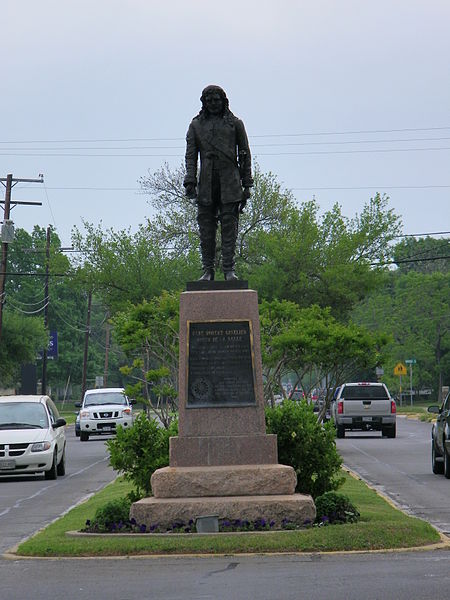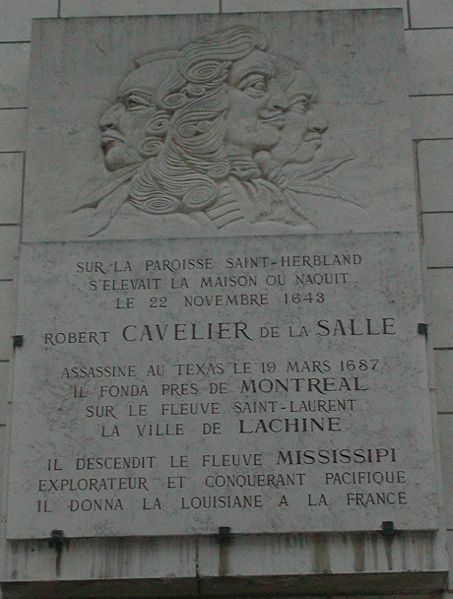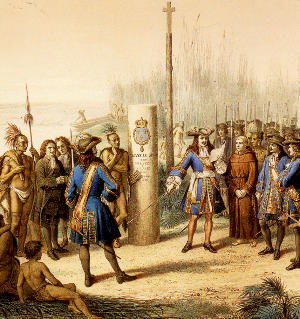<Back to Index>
- Explorer Rene - Robert Cavelier, Sieur de La Salle, 1643
- Writer Isaac Bashevis Singer, 1902
- Jurist and Minister of Justice Gustav Radbruch, 1878
PAGE SPONSOR



René - Robert Cavelier, Sieur de La Salle, or Robert de LaSalle (November 21, 1643 – March 19, 1687) was a French explorer. He explored the Great Lakes region of the United States and Canada, the Mississippi River, and the Gulf of Mexico. La Salle claimed the entire Mississippi River basin for France.
La Salle was born on November 21, 1643, in Rouen, France. When Robert de La Salle was younger he enjoyed science and nature. His real name was Robert Cavelier. As a man, he studied with the Jesuit religious order, and became a member after taking his vows in 1660. On March 27, 1667 at his request, he was released from the Society of Jesus after citing "moral weaknesses". Although he left the order and later became hostile to it, historians sometimes described him incorrectly as a priest or a cleric.
La Salle never married. He had an older brother named "Jean" who was a Sulpician priest.
Required to reject his father's legacy when he joined the Jesuits, La Salle was nearly destitute when he traveled as a prospective colonist to North America. He sailed for New France in the spring of 1666. His brother Jean, a Sulpician priest, had moved there the year before. La Salle was granted a seigneurie on land at the western end of the Island of Montreal, which became known as Lachine. (This was apparently from the French la Chine, meaning China. Some sources say the name referred to La Salle's desire to find a route to China, though the evidence for this claim is unclear and has been disputed).
La
Salle immediately began to issue land grants, set up a village and
learned the languages of the native peoples, mostly Mohawk in this area. The Mohawk told him of a great river, called the Ohio, which flowed into the Mississippi River. Thinking the river flowed into the Gulf of Mexico, La Salle began to plan for expeditions to find a western passage to China. He sought and received permission from Governor Daniel Courcelle and Intendant Jean Talon to embark on the enterprise. He sold his interests in Lachine to finance the venture.
La Salle led an expedition in 1669 in which he is alleged (by others, he never made this claim himself) to have reached the Ohio River and followed it downstream to as far as what is now Louisville, Kentucky. The falls there prevented his continuing further.
The Dictionary of Canadian Biography Online states that when the La Salle party met with a group of Seneca Indians south of present day Rochester, New York, they were discouraged by the Senecas from continuing into their territory. Consequently the party continued along Lake Ontario to Burlington Bay, where they met Adrien, the brother of Louis Jolliet, returning from a fur trading expedition on the Great Lakes. He advised them to traverse to Lake Erie thus bypassing the Seneca tribe. La Salle, however, became ill and abandoned the mission, leaving the two missionaries, Dollier de Casson and Bréhant de Galinée, to continue without him.
Another source states: "His group had 12 men in five canoes. Père Francois Dollier de Casson traveled with La Salle as far as Hamilton, Ontario, with seven men in another three canoes. There the party met Joliet's brother, who was returning to Montreal. On his advice, they went on to what is now known as Sault Ste. Marie to establish a mission to the Potawatomi. They were unsuccessful."
It was not until 1673 that Louis Jolliet and Père (Father) Jacques Marquette explored the upper Mississippi Valley, including the area where it was joined by the Ohio River. La Salle later participated in an expedition to follow the northern shore of Lake Erie to Michilimackinac.
On July 12, 1673, the Governor of New France, Louis de Buade de Frontenac, arrived at the mouth of the Cataraqui River to meet with leaders of the Five Nations of the Iroquois to encourage them to trade with the French. While the groups met and exchanged gifts, Frontenac's men, led by René - Robert Cavelier de La Salle, hastily constructed a rough wooden palisade on a point of land by a shallow, sheltered bay. Originally the fort was named Fort Cataraqui but was later renamed Fort Frontenac by de La Salle in honor of La Salle's patron. The intent of Fort Frontenac was to control the lucrative fur trade in the Great Lakes Basin to the west. The fort was also meant to be a bulwark against the English and Dutch, who were competing with the French for control of the fur trade. La Salle was left in command of the fort in 1673.
Thanks
to his powerful protector, the discoverer managed, during a voyage to
France in 1674 – 75, to secure for himself the grant of Fort Cataracoui
and acquired letters of nobility for himself and his descendants. With Frontenac's support, he received not only a fur trade concession, with permission to establish frontier forts, but also a title of nobility. He returned and rebuilt Frontenac in stone. An Ontario Heritage Trust plaque
describes René - Robert Cavelier de La Salle at Cataracoui as "[a]
major figure in the expansion of the French fur trade into the Lake
Ontario region, Using the fort as a base, he undertook expeditions to
the west and southwest in the interest of developing a vast fur trading
empire." Henri de Tonti joined his explorations as his lieutenant.
On August 7, 1679, La Salle set sail on the ship Le Griffon, which he and Tonti had constructed on the upper Niagara River. At Fort Conti, which they had built at the mouth of the Niagara River on Lake Ontario a few months earlier, they shifted supplies and materials brought from Fort Frontenac into smaller boats, canoes or bateaux. They wanted to be able to travel up the lower part of the shallow Niagara River, to what is now the location of Lewiston, New York. The Iroquois had a well established portage route in the area which they used to avoid the rapids and the cataract later known as Niagara Falls.
La Salle used Le Griffon to sail up Lake Erie to Lake Huron, then up Huron to Michilimackinac and on to present day Green Bay, Wisconsin. La Salle then departed with his men in canoes down the western shore of Lake Michigan. In January 1680, La Salle's men built a stockade at the mouth of the Miami River (now St. Joseph River). They called it Fort Miami (now known as St. Joseph, Michigan). There they waited for Tonti and his party, who had crossed the peninsula on foot.
Tonti
arrived on November 20; on December 3, the entire party set off up the
St. Joseph, which they followed until they had to take a portage at present day South Bend, Indiana. They crossed to the Kankakee River and followed it to the Illinois River. There they built Fort Crèvecoeur, which later led to the development of present day Peoria, Illinois. La Salle set off on foot for Fort Frontenac for supplies. While he was gone, Louis Hennepin followed the Illinois River to its junction with the Mississippi. La Salle was captured by a Sioux war party and carried off to Minnesota. The soldiers at Ft. Crevecoeur mutinied, destroyed the fort, and exiled Tonti, whom La Salle had left in charge. Later La Salle captured the mutineers on Lake Ontario. He eventually rendezvoused with Tonti at St. Ignace, Michigan.
La Salle reassembled a party for another major expedition. In 1682 he departed from present day Fort Wayne with 18 Indians and canoed down the Mississippi River. He named the Mississippi basin La Louisiane in honor of Louis XIV and claimed it for France. At what later became the site of Memphis, Tennessee, La Salle built the small Fort Prudhomme. On April 9, 1682, at the mouth of the Mississippi River near modern Venice, Louisiana, La Salle buried an engraved plate and a cross, claiming the territory for France.
In 1683, on his return voyage, La Salle established Fort Saint Louis of Illinois, at Starved Rock on
the Illinois River, to replace Fort Crevecoeur. He appointed Tonti to
command the fort while La Salle traveled to France for supplies. On July
24, 1684, La Salle departed France and returned to America with a large expedition designed to establish a French colony on the Gulf of Mexico, at the mouth of the Mississippi River. They had four ships and 300 colonists. The expedition was plagued by pirates, hostile Indians, and poor navigation. One ship was lost to pirates in the West Indies, a second sank in the inlets of Matagorda Bay, and a third ran aground there. They founded Fort Saint Louis, on Garcitas Creek in Victoria County, Texas. La Salle led a group eastward on foot on three occasions to try to locate the mouth of the Mississippi.
During another search for the Mississippi River, La Salle's remaining 36 men mutinied, near the site of present Navasota, Texas. On March 19, 1687, La Salle was slain by Pierre Duhaut during an ambush while talking to Duhaut's decoy, Jean L'Archevêque. They were "six leagues" from the westernmost village of the Hasinai (Tejas) Indians. Duhaut was killed to avenge La Salle, while Jean L'Archevêque was killed in 1720 by Indians during the Villasur expedition — ironically, in an ambush beside a river.
The colony lasted only until 1688, when Karankawa speaking Native Americans killed the 20 remaining adults and took five children as captives. Tonti sent out search missions in 1689 when he learned of the settlers' fate, but failed to find survivors.
There is some disagreement about accepting Navasota as the site of La Salle's death. The historian Robert
Weddle, for example, believes that La Salle's travel distances have
been miscalculated. Weddle thinks that La Salle was murdered just east
of the Trinity River, which would put the site somewhere about 20 miles (32 km) east or east - northeast of today's Huntsville, Texas.
In 1995, La Salle's primary ship La Belle was discovered in the muck of Matagorda Bay. It has been the subject of archeological research. Through an international treaty, the artifacts excavated from La Belle are owned by France and held in trust by the Texas Historical Commission. The collection is held by the Corpus Christi Museum of Science and History. Artifacts from La Belle are shown at nine museums across Texas. The wreckage of La Salle's ship L'Aimable has yet to be located. The possible shipwreck of Le Griffon in Lake Michigan is the subject of a lawsuit concerning ownership of the artifacts.
His
lover's name remains a mystery, though the legend of Krakana Belle, his
assumed daughter, lives on in the Matagorda Bay area.
